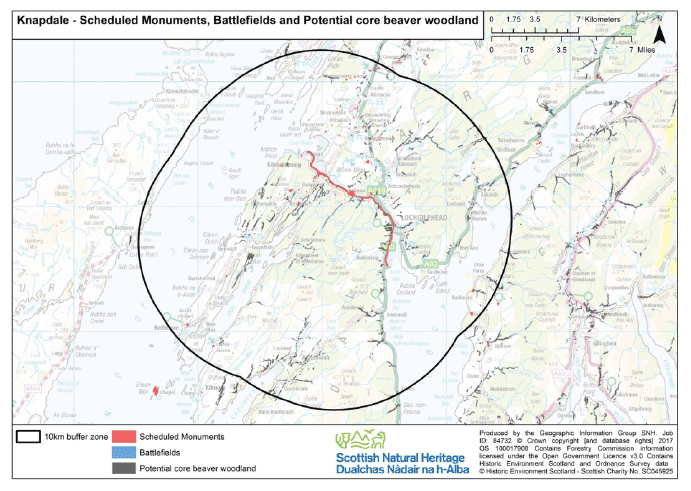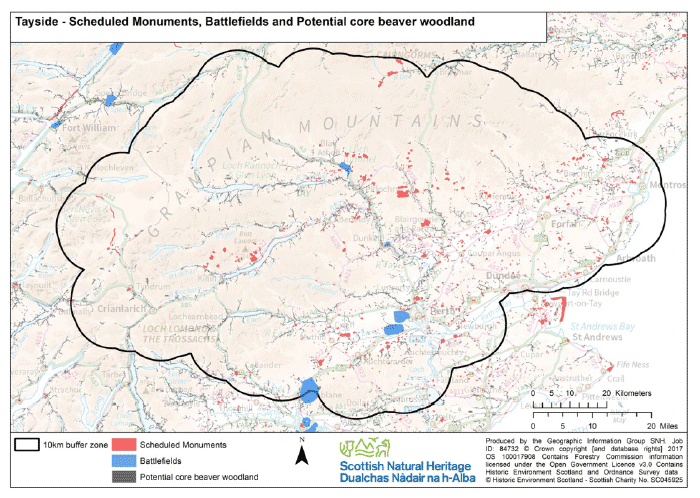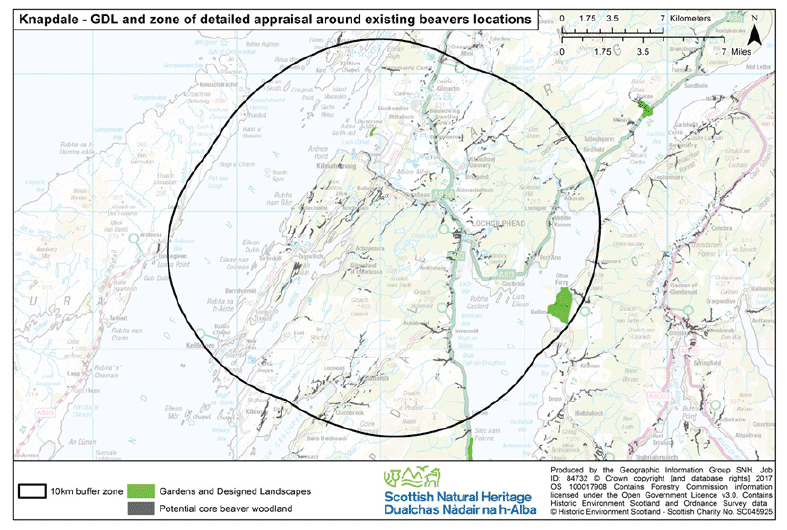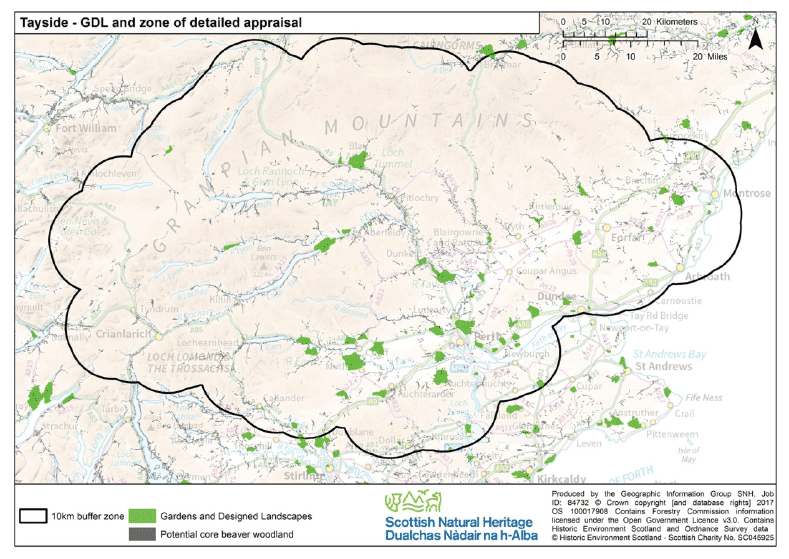Beavers in Scotland: consultation on the strategic environmental assessment
A consultation on the policy to reintroduce beavers to Scotland and the strategic environmental assessment of this policy.
4.13 Beavers and Cultural Heritage
4.13.1 How Beaver activity affects the Cultural Heritage
Historically important monuments and structures
As detailed in section 4.1, beavers are burrowing animals that dig into banks along suitable water courses, lined with deciduous tree cover to create dens. They will also utilise suitable islands for shelter and foraging. They create scrapes, slides and bankside dens in particular areas of their territories and will therefore have an impact upon some banks of watercourses. They dive to shallow depths to dig up tubers of aquatic plants and use nearby bankside mud when building lodges and dams. In the course of constructing these, trees are felled and the timber floated to the required location. Accordingly, there is the potential for beaver activity, for example through burrowing causing subsidence, or dam-building causing localised floods, to affect historic sites.
There appear to be no documented cases of beavers damaging archaeological sites, but beavers' use of timber for construction material and underwater foraging could mean that any exposed timbers or archaeological deposits on, for example, crannog sites could be at risk from disturbance. In addition to potential direct impacts on submerged features from the above activity, the potential for changes in water levels which could affect the preservation of organic remains on such sites.
Gardens and Designed Landscapes
Ornamental gardens and ponds that connect to watercourses may be occupied by beavers. In most cases they may not be present for very long, but they can radically alter the aesthetic appearance by felling ornamental trees, burrowing or feeding on garden plants. Ornamental gardens and arboreta are relatively common features in Scottish, and the wider British, landscapes, with some being of international importance. Large specimen trees in the vicinity of watercourses can be readily protected, although this may be harder for multi-stemmed shrubs or other palatable vegetation. It is likely that they will feed on a range of plant species that do not occur in their natural habitats.
Other cultural benefits derived from the reintroduction of Beavers
The Beavers in Scotland ( BiS) report studied the interaction of beavers with the Human Environment. This considered the socio-economic implications of the reintroduction policy, the economic arguments of which are largely outwith the scope of the environmental assessment. However, it does illustrate the cultural value that people and local communities place on having beavers reintroduced into the environment. This was illustrated in the public support for the reintroduction which came out of the public consultation and survey work in particular. These benefits include recreational and educational value and a 'non-use' value attributed to the reintroduction of a charismatic species.
Table 4.13.1 Summary of positive and negative effects of beaver on cultural heritage interests
| Activity |
Mechanism |
Positive effects |
Negative effects |
Notes |
|---|---|---|---|---|
| Felling |
Change in riparian woodland: Opening of woodland canopy and increased patchiness |
|
||
| Felling |
Change in riparian woodland: Change in relative abundance of different tree species |
|
||
| Felling and Constructions |
Changes in amount/diversity of woody material in watercourses |
|
|
|
| feeding |
Feeding on specific terrestrial herbaceous and aquatic plant species |
|
||
| Dams/pond creation |
Change in hydrological processes on riparian and downstream habitat |
- increased flood storage, and therefore a decrease in downstream flooding, maintaining water levels which could help in the preservation of submerged organic remains. |
|
|
| Dams/pond creation |
Changes in water quality downstream |
|
|
|
| Other constructions |
Creation of lodges, burrows, canals etc. |
|
||
| Other |
|
These types of impacts are not connected to any single beaver activity per se, and may relate to the mere presence of beavers (e.g. as an 'iconic' animal). Also relates to socio-economic 'existence' values, and the bequest value for future generations. |
||
| Indirect habitat creation/restoration initiatives as result of beaver presence |
Beaver used to promote opportunities for riparian and freshwater habitat creation /restoration |
|
This may include positive impacts on tourism (e.g. for wildlife watching associated with riparian and freshwater habitats). Also relates to socio-economic 'existence' values, and the bequest value for future generations |
4.13.2 Distribution of historically important monuments and structures within Policy Areas
4.13.2.1 Scheduled monuments in Knapdale and Tayside
Maps 20 and 21 and table 4.13.2 below detail the sites and locations of Scheduled Monuments within the Knapdale and Tayside potential core beaver woodland Policy Areas. Within this area beaver activity and impacts will be restricted to some freshwater features and the immediate riparian habitat. For ease of reading, larger maps are also included at A3 size in Appendix 1.
Map 20 Knapdale Scheduled Monuments, Battlefields and potential core beaver woodland

Map 21 Tayside Scheduled Monuments, Battlefields and potential core beaver woodland

Table 4.13.2 Scheduled Monuments and potential core beaver woodland in the beaver policy areas
| Scheduled Monument title |
Policy area |
|---|---|
| Achnamara, clapper bridge, Knapdale |
Knapdale |
| Barnluasgan, enclosures |
Knapdale |
| Cnoc Mhic Eoghainn, motte 170m WSW of Ballimore |
Knapdale |
| Crinan Canal, Cairnbaan - Ardrishaig |
Knapdale |
| Crinan Canal, Crinan to Cairnbaan |
Knapdale |
| Crinan Canal, Loch a' Bharain canal feeder |
Knapdale |
| Loch Coille-Bharr, mill and lade, Knapdale |
Knapdale |
| St Columba's Cave, cave and chapel, Knapdale |
Knapdale |
| Ardblair Castle, earthwork |
Tayside |
| Ardoch, Roman military complex 900m NNE of Ardoch Bridge |
Tayside |
| Auchenlaich, fort |
Tayside |
| Auchrannie, enclosure |
Tayside |
| Balhomie, cup-marked stone |
Tayside |
| Balintyre, homestead |
Tayside |
| Ballownie, mound |
Tayside |
| Balnaguard, settlements & field systems |
Tayside |
| Bandirran, stone circle & standing stones |
Tayside |
| Bertha, Roman fort |
Tayside |
| Bochastle Roman fort, temporary camp and prehistoric enclosures |
Tayside |
| Braclaich, deserted township & field system |
Tayside |
| Broich, cursus, ring-ditch, barrow & palisade 600m SE of Duchlage |
Tayside |
| Campsie Linn, grange site |
Tayside |
| Cardean Roman Camp and pre-historic barrow, Wester Cardean |
Tayside |
| Cardean, Roman fort 230m NW of Cardean Mill |
Tayside |
| Carnbane Castle, Glen Lyon |
Tayside |
| Castle Campbell |
Tayside |
| Castle Hill, motte W of Mains of Cargill |
Tayside |
| Clunie, Castle Hill and The Ward, motte,castle and settlement |
Tayside |
| Colliston Castle, enclosure, souterrain, ring ditches & pit alignment |
Tayside |
| Comrie Castle |
Tayside |
| Cragganester, farmsteads, field systems, shielings and roadways |
Tayside |
| Craig Hill, fort and broch |
Tayside |
| Creag Eilid, settlements, field system and cairn |
Tayside |
| Damside, fort |
Tayside |
| David's Hill, enclosure |
Tayside |
| Doune Castle |
Tayside |
| Doune Roman Fort, fort 60m S of Doune Primary School |
Tayside |
| Duncroisk, cup & ring marked rocks |
Tayside |
| Dundurn Fort, fort St Fillan's Hill |
Tayside |
| Dunkeld Cathedral |
Tayside |
| Edinchip, chambered cairn |
Tayside |
| Elcho Castle |
Tayside |
| Finavon Castle |
Tayside |
| Findynate, homestead |
Tayside |
| Fisherhills, fort |
Tayside |
| Foirche, settlement, Dalshian |
Tayside |
| Friock Mains, pit alignment |
Tayside |
| Glasclune Castle |
Tayside |
| Glenbran, ring fort |
Tayside |
| Gleneagles Castle, tower and earthwork |
Tayside |
| Grassy Walls, Roman camp and prehistoric settlement, Sheriffton |
Tayside |
| Haugh of Grandtully, fort |
Tayside |
| Huntingtower Castle |
Tayside |
| Hurly Hawkin, enclosure, broch and souterrain |
Tayside |
| Inchbervis Castle |
Tayside |
| Inchrye, motte |
Tayside |
| Inchtuthil, Roman fortress |
Tayside |
| Innerpeffray Wood, Roman camps |
Tayside |
| Innes Bhuidhe, forts, NE of Bridge of Dochart |
Tayside |
| Invercauld Bridge |
Tayside |
| Invergighty Cottage, barrow cemetery N of Boysack |
Tayside |
| Invermark Castle and township 220m SW of House of Mark |
Tayside |
| Inverquharity, Roman fort, Roman camp and Iron Age settlement |
Tayside |
| Invervar, shrunken township, Glen Lyon |
Tayside |
| Kerrowmore, motte and settlement 590m S of Innerwick |
Tayside |
| Kilspindie, unenclosed settlement N of Mill House |
Tayside |
| Kinclaven Castle |
Tayside |
| Kinnaird, settlements & field systems |
Tayside |
| Lassintullich, St Blane's Chapel |
Tayside |
| Loch of Kinnordy, crannog 500m NW of Balbrydie |
Tayside |
| Lochleven Castle |
Tayside |
| Lowbank, souterrain |
Tayside |
| Lui Water, townships 800m to 2780m SE of Derry Lodge |
Tayside |
| Lundin, dun |
Tayside |
| Meikleour House, motte |
Tayside |
| Millearnwood, Roman Road, 450m N of Raith |
Tayside |
| Millhaugh, enclosures and other cropmarks |
Tayside |
| Milton of Ogil ring ditch |
Tayside |
| Moulinearn, military bridge, Mill Lands of Dalcapon |
Tayside |
| Netherton, enclosure |
Tayside |
| Newhall Bridge, two standing stones |
Tayside |
| Old Faskally Farm, church |
Tayside |
| Old Lawers Village, deserted settlement, Lawers Acres |
Tayside |
| Orchill Fort, fort 450m NNE of Orchill |
Tayside |
| Panmure Castle and Moat |
Tayside |
| Parkhead, ring-ditch, souterrain and enclosure |
Tayside |
| Pitcarmick Estate, settlements, field systems and cairns |
Tayside |
| Pitmiddle, deserted village |
Tayside |
| Pitroddie Farm, souterrain and unenclosed settlement |
Tayside |
| Powmouth, settlement 400m E of Haughs of Kinnaird |
Tayside |
| Prince Charlie's Bridge, military bridge, Dalcapon Wood |
Tayside |
| Rait Hill, fort |
Tayside |
| Restenneth Priory |
Tayside |
| Ryehill, unenclosed settlement |
Tayside |
| St Blane's Chapel |
Tayside |
| Stormont Loch, crannog |
Tayside |
| Stracathro, Roman fort and camp |
Tayside |
| Strageath Mains, Roman fort, annexe and field system |
Tayside |
| Strowan Church, church and burial ground |
Tayside |
| Tirai, settlement and standing stone |
Tayside |
| Tom na Croiche, castle |
Tayside |
| Tyndrum, lead mines and associated remains |
Tayside |
| Vayne Castle, castle 290m SSW of Vayne |
Tayside |
| Wester Tullich, sulphuric acid works |
Tayside |
| Whiteloch, ring-ditch |
Tayside |
4.13.2.2 Battlefield sites
The table 14.13.3 below and maps 20 and 21 above and in Appendix 1 detail the location of the Battlefield sites within the Tayside beaver policy area. Within this area beaver activity and impacts will be restricted to some freshwater features and the immediate riparian habitat.
There are no battlefield sites in Knapdale which overlap with potential core beaver woodland.
Table 4.13.3: Battlefield sites and potential core beaver woodland in the beaver policy area
| Battle of Dunkeld |
Tayside |
| Battle of Dupplin Moor |
" |
| Battle of Killiecrankie |
" |
| Battle of Sheriffmuir |
" |
| Battle of Tippermuir |
" |
4.13.2.3 Gardens and Designed Landscapes
Table 4.14.4 and maps 22 and 23 below (see also Appendix 1) detail the location of the Gardens and Designed Landscapes within the Knapdale and Tayside beaver policy areas and overlap with potential core beaver woodland. Within this area beaver activity and impacts will be restricted to some freshwater features and the immediate riparian habitat.
Map 22 Knapdale Gardens and Designed Landscapes and potential core beaver woodland

Map 23 Tayside Gardens and Designed Landscapes and potential core beaver woodland

Table 4.13.4: Gardens and Designed Landscapes and potential core beaver woodland in the beaver policy areas
| GDL title | PA code | |
|---|---|---|
| Knapdale | Ballimore | 8779 |
| Tayside | Abercairny | 8742 |
| Tayside | Aberuchill Castle | 8744 |
| Tayside | Airlie Castle | 8749 |
| Tayside | Balmanno | 8782 |
| Tayside | Blair Castle | 8796 |
| Tayside | Blair Drummond | 8797 |
| Tayside | Bolfracks | 8800 |
| Tayside | Braco | 9212 |
| Tayside | Brechin Castle | 8804 |
| Tayside | Castle Campbell | 9216 |
| Tayside | Castle Menzies | 8823 |
| Tayside | Cleish Castle | 9219 |
| Tayside | Cluny House | 8830 |
| Tayside | Corrour Lodge | 8832 |
| Tayside | Cortachy Castle | 8833 |
| Tayside | Cowden Japanese-Style Garden | 10439 |
| Tayside | Craighall Rattray | 8835 |
| Tayside | Doune Park | 8863 |
| Tayside | Drummond Castle | 8867 |
| Tayside | Dunira | 8877 |
| Tayside | Dunkeld House | 8878 |
| Tayside | Dupplin Castle | 9226 |
| Tayside | Falls of Bruar | 9229 |
| Tayside | Fingask Castle | 8894 |
| Tayside | Glamis Castle | 8904 |
| Tayside | Glendoick | 8911 |
| Tayside | Grantully Castle | 8915 |
| Tayside | Guthrie Castle | 8918 |
| Tayside | House of Dun | 8928 |
| Tayside | House of Pitmuies | 8930 |
| Tayside | Invercauld | 8938 |
| Tayside | Invermay | 9233 |
| Tayside | Keillour Castle | 8942 |
| Tayside | Keir | 8943 |
| Tayside | Kinfauns Castle | 8950 |
| Tayside | Kinnaird Castle | 8955 |
| Tayside | Kinross House | 8957 |
| Tayside | Meggernie Castle | 8984 |
| Tayside | Megginch Castle | 8985 |
| Tayside | Meikleour | 8986 |
| Tayside | Melville House | 8990 |
| Tayside | Methven Castle | 8992 |
| Tayside | Monzie Castle | 9238 |
| Tayside | Murthly Castle | 8998 |
| Tayside | Ochtertyre | 9010 |
| Tayside | Rossie Priory | 9032 |
| Tayside | Scone Palace | 9038 |
| Tayside | Stobhall | 9046 |
| Tayside | Taymouth Castle | 9051 |
| Tayside | The Burn | 9052 |
| Tayside | The Gleneagles Hotel | 9056 |
| Tayside | The Guynd | 9057 |
| Tayside | The Hermitage | 9059 |
| Tayside | The Roman Camp | 9248 |
4.13.3 Assessment of effects on cultural heritage interests within the beaver policy areas
Knapdale
At Knapdale, Historic Scotland monitored potential beaver impacts on a crannog on Loch Coille-Bharr, in particular to assess whether foraging on aquatic plants might affect the scheduled monument. Loch Coille-Bharr crannog (Scheduled Monument Index No. 10131) is a submerged artificial island presumed to be the site of a late prehistoric - early historic period lake dwelling. The recovery of timber artefacts from the site in 1867 suggests that the lake silts around the site have preserved organic deposits relating to the occupation and use of the crannog. No impact was observed and the likelihood of impact was thought to be low. The Crinan Canal (Scheduled Monument Index Nos. 6500 and 6501) is an historic and well used waterway, mostly consisting of clay-lined earthen banks with intermittent areas of stone pitching revetting the banks. The canal is fed by a system of streams and lochs, mostly unscheduled. No impact was observed during the trial period on the Canal.
The Knapdale beaver population would be expected to expand, with some likely further impacts on forestry infrastructure. This might include some flooding of tracks and other infrastructure resulting from beaver dam-building activity (including attempts to block culverts) and some occasional felling of trees onto tracks and footpaths. Animals will eventually start to move outside the forest itself, with increasing incidences of the types of impacts described above in the wider area. Continued monitoring would be required along the Crinan Canal, in particular to look for any burrowing into the canal embankments and for any beaver activity in the feeder lochs above the canal.
There is only one Garden and Designed Landscape which overlaps with core beaver woodland at Ballimore. There are no known Battlefield sites within the Knapdale Beaver Policy Area.
Tayside
The effects on the cultural heritage interests in Tayside have not been analysed to the same degree as the study at Knapdale. However, there have been nine records of beaver impacts on ornamental and amenity value trees in private gardens in Tayside. There was also a record of a fish pond being flooded.
The overall findings and recommended mitigation and monitoring measures from the study in Knapdale could be applied similarly to both submerged features and archaeological interests with riverine areas in Tayside. Table 4.13.1 above details the range of positive and negative effects with consequent implications for cultural ecosystem services. There are 97 scheduled ancient monuments coincide with the core beaver woodland within the Tayside Policy area, 5 Battlefield sites and 54 Gardens and Designed Landscapes.
4 .13.4. Mitigation Measures
There are a number of methods that can be used to protect cultural heritage interests and in some cases it may be prudent to protect especially sensitive interests before problems arise. This is more achievable for small-scale structures, such as individual features. The pre-emptive protection of larger scale structures that may be vulnerable to beaver activity, such as canals and settlements and earthworks, would be more challenging. The scale and costs involved for revetment or reinforcement to prevent burrowing would be high. There would therefore be a need to identify and prioritise those structures that may be most vulnerable. Scotland could draw on European approaches to targeting sites for management, and GIS-based tools to identify areas where beaver activity is predicted to be more likely.
There are other issues that might affect small numbers of individuals, for example damage to ornamental trees and gardens. For these, and the more complex infrastructure issues described above, the development of an appropriate management framework will be required. This will need to include guidance on management techniques (for both pre-emptive and reactive actions) and information on sources of advice and support. The effectiveness of beaver management in Scotland will increase over time as experience is gained and methods refined.
Section 5 also details the hierarchy of mitigation techniques that can be used to address impacts from beaver activities, including generic management and licencing approaches to more practical measures including those addressing:
- Dam building activities
- Burrowing activities and
- Foraging activities
These mitigation measures apply to the potential negative effects identified in relation to beaver activity and the cultural heritage.
Contact
There is a problem
Thanks for your feedback